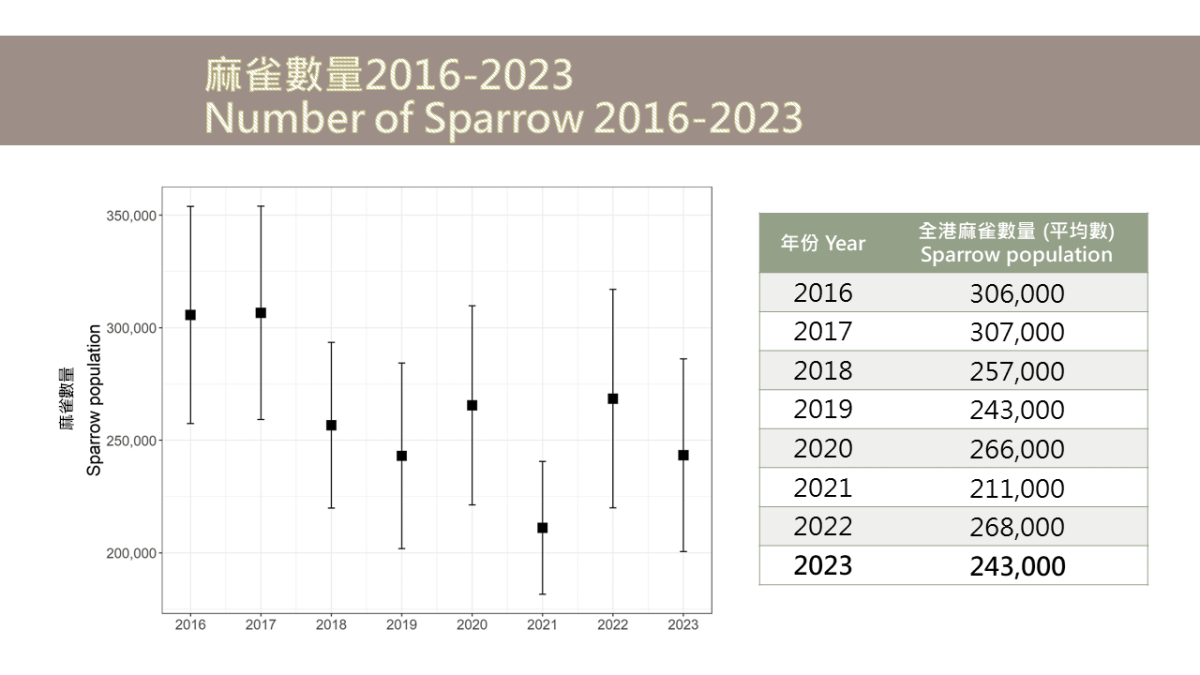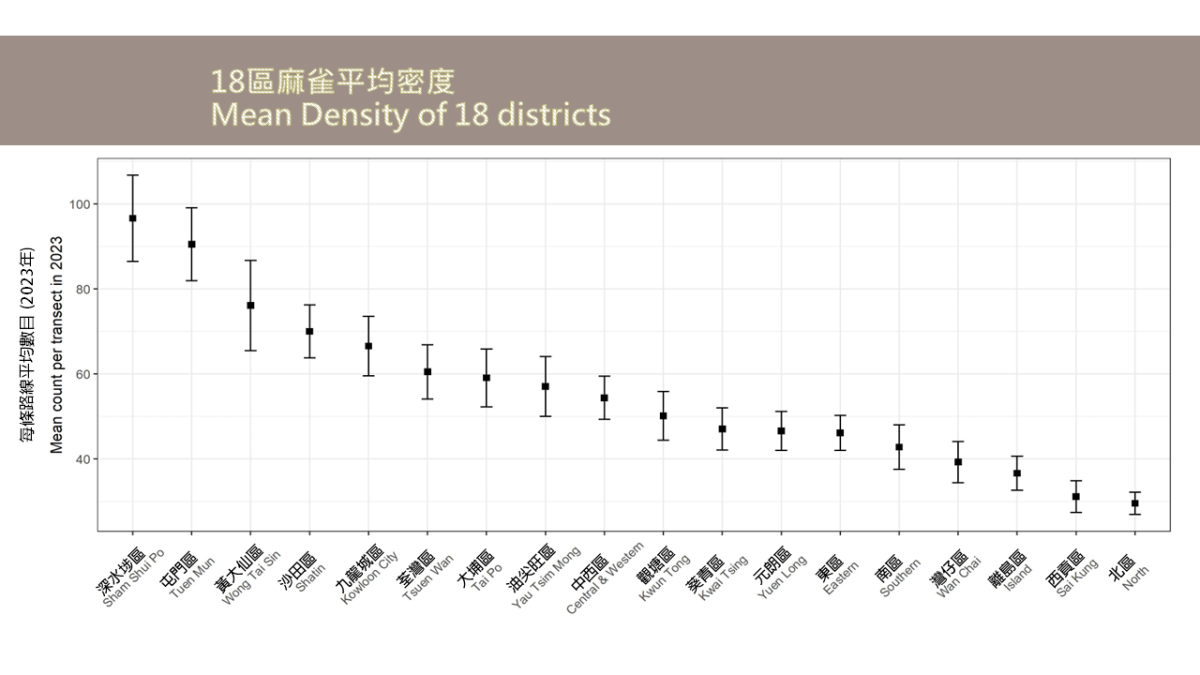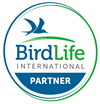The 8th Hong Kong Sparrow Census organized by the Hong Kong Bird Watching Society (HKBWS) estimates that there are approximately 243,000 Eurasian Tree Sparrows (referred to as “sparrows” below) in the urban areas of Hong Kong, a slight decrease of about 10% from the previous year. Except for 2021, the sparrow population has remained between 240,000 to 270,000 over the past 6 years, indicating a stable trend. The Hong Kong Bird Watching Society believes that at least 10 years of continuous monitoring are needed to accurately understand population trends. They urge citizens to "count more, know more" for continuous monitoring, so as to facilitate deeper research and collaborate to create a bird-friendly city.

Hong Kong population slightly dropped to 243,000, while highest density found in Sham Shui Po District
As in previous years, the 2023 census was held in May and included 88 one-kilometer routes covering all 18 districts in Hong Kong. Based on the results, there are approximately 243,000 sparrows in Hong Kong, a decrease of about 10% from last year’s count of 268,000 sparrows. Except for rural and commercial areas, sparrow numbers decreased in other land-use categories compared to previous year. When categorized by land use, the areas with the most sparrow clusters are village-typed areas, residential areas, and recreational areas. If categorized by 18 districts of Hong Kong, Sham Shui Po District continues to be the area with the highest density of sparrows, closely followed by Tuen Mun District and Wong Tai Sin District.
For the fourth consecutive year, the census included 4 common urban bird species: the Spotted Dove, Oriental Magpie-robin, Red-whiskered Bulbul, and Red-billed Blue Magpie. This year's urban bird census estimates there are 58,000 Spotted Doves, 17,000 Oriental Magpie-robins, 60,000 Red-whiskered Bulbuls, and 3,600 Red-billed Blue Magpies in the urban area. The numbers of the first three species decreased compared to last year, while the number of Red-billed Blue Magpies increased. It is also the first time that these magpies were recorded in agricultural and industrial areas.

Raising awareness for urban crisis faced by wild birds and promoting a "bird-friendly" city
In its eighth year, the sparrow census has seen fluctuations from around 300,000 sparrows in 2016, hitting a low of 210,000 in 2021, and then rebounding slightly this year. Although the numbers have stabilized, HKBWS hopes that the public will collectively address and eliminate the various hidden crises faced by urban birds. Glass buildings and rodent glue boards are two of the crises these birds face in the city.
Since 2021, HKBWS has been collecting records of bird collisions through the "Global Bird Collision Mapper." As of this year, the platform has recorded around 250 bird collision incidents in Hong Kong, including many common urban birds. The Society encourages public participation in monitoring and reporting bird collision cases through the global mapper or its own reporting system. Property owners are urged to assess the collision risks of existing and new buildings and implement appropriate measures. The government should consider legislation similar to other regions to promote bird-friendly architecture.
Regarding rodent glue boards, wild birds are attracted to the insects stuck on the board and get trapped themselves. They struggle to free themselves and might eventually die due to injury or hunger. According to Kadoorie Farm and Botanic Garden, as of January this year, they received 25 wild birds caught in rodent glue boards, including Tree Sparrows, Oriental Magpie-robin, Spotted Doves, and other common urban birds. HKBWS hopes that the government and citizens will cease the use of rodent glue to avoid harming urban birds.
Other bird-friendly actions include using targeted pest control methods in managing parks and private estates, preserving harmless insects and invertebrates to provide food sources for wild birds; refraining from disturbing nesting birds, eggs, and nests during the breeding season from March to August, and avoiding the illegal keeping of wild birds, which could disrupt their natural behaviours and potentially violate wildlife protection laws.
Recruiting citizens for citizen science research
While the Eurasian Tree Sparrow is categorized as a "Least Concern" species on the IUCN Red List, the global population of this species is declining according to assessments by BirdLife International. Compared to other countries, the sparrow and urban bird census work in Hong Kong is still in its early stages and requires continuous monitoring of population trends for further research. HKBWS hopes for more enthusiastic citizens to become sparrow census surveyors, participating in and promoting citizen science research to increase awareness and understanding of urban ecology.






